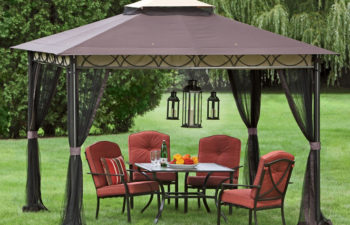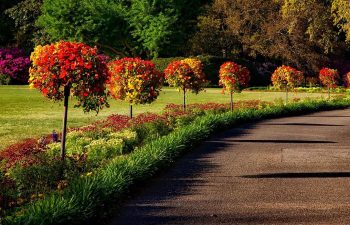Landscaping can be a pain in the neck, especially when you don’t know what your doing.
That’s why some home owners prefer to hire a landscaping designer. But you don’t need to. Landscaping is all about planting and arranging flowers and shrubs in your garden.
It’s quite easy to do landscaping design on your own.
With a little help you should be able to grasp the basic concepts. In-fact, once you get it, it’s not that hard. It’s not like you need a college degree to do landscaping.
How To Landscape Design?
The good thing is that you can break down the tasks so that you can take one at a time.
Related Post: Landscaping Design 101
You should only do what you can within a day. After all, you can’t finish the job in one day. Rushing things will only result in disappointing results.
It’s therefore important to take time and reflect on the tasks ahead so that you can decide what you will do, on which day. Don’t forget that you still have your day time job.
Landscape Your Yard On A Budget?
Put your finances together and think about your budget and how much money you want to spent.
Related Post: Landscaping Design Cost
There is no way you can landscape your garden without money. As a matter of fact, you’re limited by the amount of money you have.
Regardless of that, it’s good to be realistic because there is a difference in what you want, and what you already have at hand.
If you’re not afraid of running into debt, you can borrow a few bucks from family and friends. Nonetheless, you should stick to what you can afford. That way, you will not strain your pockets.
Since you will not be landscaping everyday, it’s better to hire some of the equipment that is needed instead of buying. This will definitely reduce your expenses.
The amount money that is needed is determined by the size of your garden. But in most cases, $1,000 is enough to see you through.
This is because you will have to buy mulch and plants among other things.
Start Landscaping At Home From Scratch
To start landscaping your backyard from scratch, you need to start with the end in mind. Consider your needs.
Related Post: Landscaping Ideas For DIY Landscapers
For best results, it’s highly recommended you start with a list of all your requirements. Carefully consider everything before you do anything on your garden.
This helps in avoiding missing out on crucial factors.
For instance, you might want to create a play-area for your kids. Additionally, you might need to leave enough space for your pets. You should also consider paths and vegetable gardens.
There is no point of having plants all over when you’re sure you will construct a swimming pool or an outdoor kitchen within your property.
Uprooting the plants later is cumbersome, and a waste of resources. You can draw a sketch map of your property with all the things that you want, even if they’re not there.
This will ensure that you don’t encroach on space that’s meant for something else.
Step-by-Step Landscaping (Don’t Ignore The Weather)
Related Post: Landscaping Design Concepts
Most homeowners tend to overlook the issue of weather when planning their landscape. The position of the plants and structures in your garden is affected by the sun, rain, and wind.
An outdoor kitchen will not function well if it’s exposed to the wind. A patio should be located in an area that’s not affected by the sun because your guests might not use it.
Rain water can also affect your grilling area. It’s therefore important to consider the slope of your garden, because that’s where ground water will go.
Since most homeowners landscape their gardens during hot weather, they may not know how rain water flows around their homes.
You can wait for the rains to come so that you can observe, or if you’re impatient, pour a few buckets of water on the ground.
Landscaping for Beginners (Make Baby Steps)
Related Post: Landscaping Design for Beginners
Don’t get it twisted; it’s not easy for a beginner to finish landscaping a big portion of their property in a couple of hours.
The people you see on TV make it look like a walk in the park. If you’re a keen observer, you might have noticed that they have people to help them out with some tasks, and that’s why they finish within a short time.
In-fact, you should divide the property into small beds to avoid overwhelming yourself with work. The advantage of starting small is that you can easily notice mistakes and correct them early enough.
Avoid Landscape Design Congestion
Related Post: Landscaping Design Layouts
Congestion is experienced when there is a mismatch between plants and the available space. When shopping for landscaping plants, you should buy plants that will not cover the entire garden and obstruct the other elements.
The features of a shrub or a tree are usually indicated on one side of the bag. It’s therefore insane to plant a tree that measures 40 inches wide on a garden of 50×50.
If you have a small property, you should settle for trees and shrubs that grow straight.
On the other hand, wide and tall plants are ideal for big properties. A big property looks empty when the plants are short. In such a case, you should go for shrubs that grow tall enough to cover half the height of the house.
Besides that, plants that have many branches should be located somewhere in the middle of the garden because they can be problematic for your fence.
Embrace Elements of Design in Your Landscape
Related Post: Landscaping Design Principles
Landscaping like a pro requires you to think like an artist. You should paint an imaginary picture in your mind to get an overview of how your home will look.
Elements of design include color, form, pattern, light, balance, contrast, rhythm, variety, and unity.
Different plants have different colors, and that’s why you should avoid placing those that have the same color in one area. You should mix them a little to create a balance.
Just remember that the plants will eventually grow tall and affect the distribution of light within your home. It’s also important to come up with a pattern that’s easy to identify.
Moreover, there are plants that don’t grow well when they’re planted close to each other. For instance, bamboo is slow to grow when paired with a rhizome.
You can create rhythm by positioning a certain variety of plants in a sequence. After all, you should not be afraid of exploiting your creativity because that’s what amounts to perfection.
You can even bend some rules by planting some shrubs outside the bed.
Related Post: Landscaping With Evergreen Shrubs













